
Someone with ADHD is often described as “needing help.” But what these people really need are the same things that everyone needs. The ADHD Hierarchy of Needs is a model that describes the needs of people with ADHD, and how they can be addressed. It’s important to note that this model is not meant to be a list of rules or expectations—it’s not a prescription for how your life should look. It’s simply meant to help you understand what your needs are, so that you can make decisions about what you want and need in your life.
Physiological
Physiological needs are the most basic and most fundamental of all human needs. They include: Food and water, Sleep, Sex (if you’re into it), Cleanliness and sanitation, e.g., hygiene products, clean clothes, bathrooms to use when they need them, Safety from harm or threat and security in your home or living situation (e.g., locks on doors, alarms/security systems) and Medication if necessary.
Safety
The safety need is about feeling safe. A person with ADHD may have a strong sense of danger, which makes them very sensitive to possible threats. Or they might not feel safe at all and perceive the world as a dangerous place where no one will protect them from harm. These feelings can lead you to do things like: Avoid social situations or places where there’s no way out in case there’s trouble, like being trapped in an elevator or far away from home without transportation if you need to run away fast, Be constantly alert for signs of danger (like someone looking at you) so that you can avoid getting hurt or killed and Make elaborate plans with escape routes should something go wrong while doing your best not to think about it.
Love
We’re going to talk about a few different things that fall under the love and belonging category. One of these is having a sense of purpose or mission in life, which can be achieved by having a job that you enjoy or finding other ways to feel like you are making an impact on the world around you. What does this have to do with ADHD? For some people with ADHD, it feels like their lives lack meaning or direction. They may feel like they don’t belong anywhere because they cannot stay focused enough on tasks at hand, and therefore cannot follow through with projects or goals as easily as others might be able to do so. This hierarchy of needs may help illustrate how important it is for individuals who have been diagnosed with ADHD (or any mental health condition) receive treatment from qualified professionals so that they can begin working towards achieving these goals and gaining confidence along the way.
Esteem
Esteem needs are the need for self-respect and social recognition, which are closely related to self-esteem. People with ADHD often have low self-esteem because they may be unable to meet their own high expectations, or they may have trouble meeting others’ expectations of them. They feel like they’re not good enough, and that can lead to many problems in life (like depression). People with ADHD have a hard time keeping up socially because they miss cues about what’s socially acceptable and how much information is too much. This means that when someone says something inappropriate at a party, it doesn’t register like it would for someone without ADHD; he or she will just go along with it without realizing it’s inappropriate until later on when his friends point out what happened (and sometimes even then). Kids who don’t know how to manage their disorder can act impulsively; this leads people around them wondering why no one else seems as crazy as them! Because these kids usually lack the skills necessary for self-control, adults tend not want any part of them either–which makes sense if you think about all those adults who were mean during your childhood because you couldn’t control yourself!
Self-Actualization
In the late 1960s, psychologist Abraham Maslow developed a theory of how human beings fulfill their basic needs. According to his hierarchy of needs, people must meet certain requirements before they can move on to more advanced levels of development. In this article, we’ll discuss Maslow’s self-actualization needs and how they affect those who have ADHD. Self-actualization is the need for growth and development as a person—to achieve one’s full potential in both personal and professional areas. It includes being creative, independent, self-sufficient, responsible and able to relate well with others (Kagan & Snidman 2015). People with ADHD often struggle with these attributes because their symptoms may make it difficult for them to focus on tasks at hand or follow through with plans consistently over time (Barkley 2006).
People with ADHD have the same needs as anyone else. Did you know that the brain is made up of billions of neurons? These little guys communicate with each other by sending electrical signals across the gaps between them. This process is called “neurotransmission” and it happens all the time, all day long! In fact, your brain generates as much electricity as a small lightbulb—and that’s just one neuron. However, sometimes this process breaks down for people with ADHD. Their brains may have an unusually low amount of dopamine or other neurotransmitters which make it hard for them to focus or pay attention at school or work. Their brain cells also don’t seem to be communicating well because they have trouble managing their emotions or getting new tasks done on time.
We hope this information helps you understand yourself better and make the most of your unique strengths. Remember, you deserve to live a fulfilling life!
